the
180mag
editor's blog
"Anyone who listens to an artist needs their eyes examined" -Claus Oldenburg
"Anyone who listens to an artist needs their eyes examined" -Claus Oldenburg
send us an email
You can track this page with firefox add-ons
| current
issue submissions contact archive 180 studio 180 forum |
Cool Links |
my
soundtrack: folkradio.co.uk Kim Taylor my other blog: Unka Kim's Bloggie Thingie my workshops: 180 photo workshops my daily photo fix: Flak Photo |
blog
archive
|

I was reading a blog post about a website called tiltshiftmaker and it's apparently a website where you can go to change photos into tilt-shift style. That's an out of focus area on top and on bottom so that what you're left with is a landscape (usually a cityscape) that looks like a photo of a small model. The effect being the apparent result of using a view camera to shoot a tabletop with tiny depth of field.
The kiss of death of course was when the blogger mentioned "There's even a Flickr group". Up to then I was almost going to go click on the website to see what people were doing with the technique.
Why kiss of death? Let's just say that for an art photographer, if there's enough people doing it to rate a Flickr group, it's not art, it's just another tool to put into your toolbox and I don't have any use for it right now.
That's actually one of the ways I distinguish between a new way of seeing and a fad technique... or perhaps I should say that the difference between a new way of seeing and a fad technique is how many people are now shooting that way.
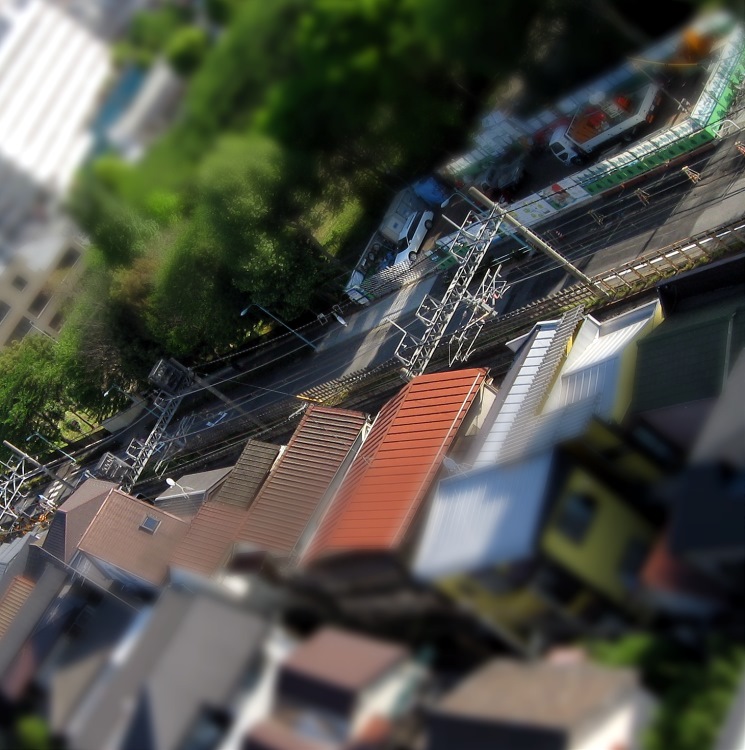
Toy Tokyo 2009, Kim Taylor
Looking over some websites this evening it occurs to me that photographers today are using the colour palette to make their work distinctive. Or perhaps in some cases, the palette of colours they prefer to use is creating a style for them.
The selection of colours (or lack of colour as in black and white) in an image, and the addition of an overall patina in post production (or toning in the "old days") is one way to make your work distinctive.
Yves Klein is perhaps best associated with the colour blue. He went so far as to develop International Klein Blue, a new blue for his work as an artist and photographer.
The saturation of colour can also express an artist's style. It is hard to mis-identify a photograph by Miles Aldridge. Of course when looking at his work you should immediately think of Guy Bourdin who was the saturation king of an earlier generation.
On the other end of the scale is the muted and desaturated work of Sarah Moon and Paulo Roversi who both use colour and focus to make their dreamy compositions.
The new generation of art/fashion photographers seem almost unconsciously to be using what I have come to call the Polaroid palette, a somewhat colour-imbalanced, desaturated look that gives a sort of un-concentrated feel to their images. Rather like their subjects, who seem mostly in the 17 to 22 age range.
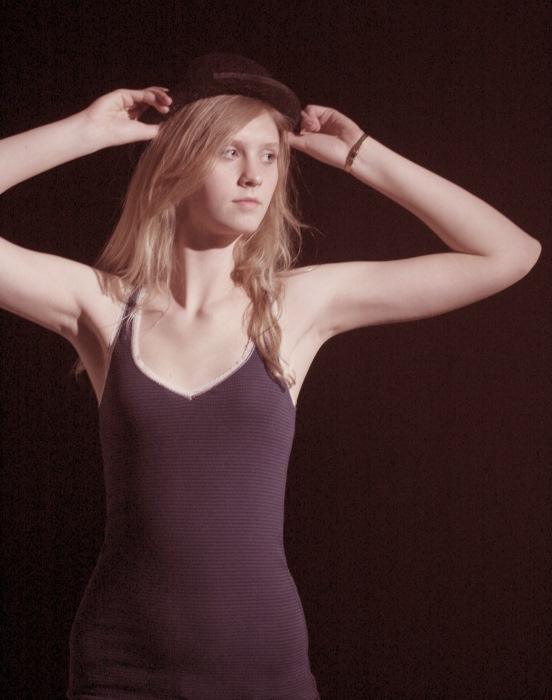
Kim Taylor, 2009
Do a google image search on these photographers and you will immediately see just how important their use of colour is to their quite recognizable style.
I've got a little note down here on my desk that just says "the language of photography" which, on a moment's reflection, sounds like about a month's worth of lectures in a University course, or a book, but I'll put down a few points to start the juices flowing.
A language is something we use to convey ideas from one person to another. Usually it's the spoken word, but quite obviously (since we're using it now) it's also the written word. Last night I watched a rather silly TV show where the hero could understand everything there was to understand about the bad guys by watching their body and facial "language", so there's the segue into visual language.
We take pictures of people, and they may smile, frown, "be a tiger" and whatnot. Those expressions will give us clues to what information we are supposed to receive. She is happy, she is.... serious? unhappy?, she is "sexy". They may have clothing on, or not. If they are dressed, how are they dressed? School uniforms, wedding gowns, prom dresses, all these tell us what we need to know. Props? Sure, we've got the serious looking guy with the stethescope around his neck, the guy in a suit with the briefcase jumping up in the air, the gal with the banana and a glint in her eye. We know what all those mean.
So what other aspects of photography convey information?
A black and white photo might say "serious landscape artist" or it may isolate patterns and textures away from colours so that we don't get distracted by them. In that case we should check out the patterns and textures.
Colours may tell us things, red for anger or excitement, blue for calmness, yellow for happy and green for "oh dear I must be sick again, I'm in the hospital".
Composition. Nothing says point-and-shoot Mom photo like that face dead centre in the image (where the focus spot is), but why is it the death-of-images? Well it's kind of disturbing that little Johnny is sliding down off the chair like that, right out of the frame. Put his face a bit further up in the image and now you've got a nice passport photo, face square on, centred in the frame, nothing happening on either side, nobody's going anywhere.
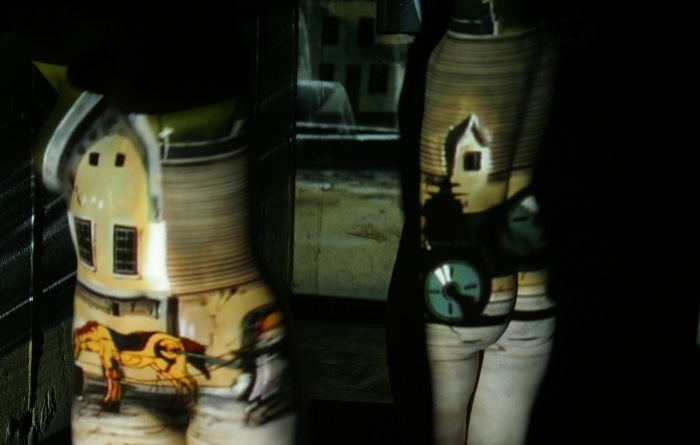
Look at all the various things you can play with in a photograph and you can start to imagine what each can be made to say.
Contrast: Low contrast is a foggy, misty day, muted colours, muffled sounds, "What Ho, Holmes, the game's afoot!" High contrast is sort of mid-day, not much hidden here, the sun's high in the sky and our iris is small so we're seeing everything in nice sharp detail. If the photo's high contrast we must be looking for information, what is this I see before me, a lovely handbag, why I can almost feel the texture of that leather.
Sharpness: Funny, this used to be focus before the USM filter and automation made the focus ring a thing of the past. I don't think sharpness says much these days when lenses are designed for it and every photo magazine tells us how to get the most from our new megapixelated digital sensors. Lack of sharpness and even out of focus images may tell us that the photographer is sick of digital slickness, or that he's an artiste, or that the makeup artist didn't make it that day and the model's skin looked like a crocodile... or perhaps we're going for a dreamy effect, something psychological.
Hue and Saturation: In a similar way, perfect white balance and highly saturated colours are probably saying "I'm shooting with all the default settings on my camera", but off-colour shots or pale colour palettes might be something to pay attention to, unless the models are in wedding dress, in which case it's obviously back to the old dreamy romantic thing again.
Blur: Obviously a lack of it means we've got the camera on a tripod, or the image stabilization (electronic, optical and/or auto-iso) is going full blast. Since it's hard to create a blurred photo these days maybe the photographer is saying something... like "I'm shooting indoors and forgot to set the auto-iso mode" or perhaps "I'm trying to convey movement". Maybe "check out the colours, I've abstracted everything else so that's all you can see".
Exposure: Get great curves and a continuous tone range from black to just under white and maybe you're saying "I got a great command of curves in Photoshop" or "hey this high dynamic range stuff is really cool". Underexpose and those dark images may just hint at subterranean emotions bubbling below the surface of Granny's wrinkled brow. Overexpose and you're now on a sunny beach in mid-afternoon. Warm sun and girls in skimpy bathing suits... what's not to like?
Go pick up your camera and see what other settings you can play with. Play with them and take a look at the shots, see what they say to you.
Now you have your own visual language to speak with, just don't forget that what you're saying may not be what your viewers are hearing. The visual language of photography is no more reliable or precise than having a discussion in a sports bar.
Can anyone say "symbolism"? Sure, I knew you could.
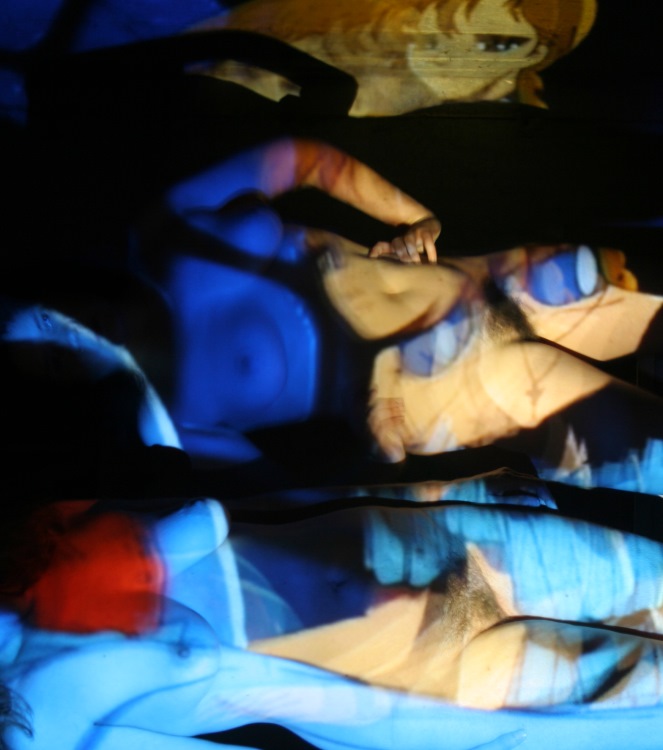
I recently spent two weeks in Japan, in Tokyo, Kyoto and the countryside of Fukuoka. I was not there for photography but of course I had a camera along with me and I noticed an interesting thing about my own street photography that I thought I'd share.
The first three or four days I was in the country I was fearless, I shoved my camera everywhere, down alleyways, into back doors, absolutely anywhere that caught my eye.
As the time whet on, I noticed that I was getting a bit more reluctant to stick the camera in someone's face, and by the end of the two weeks I was downright respectful of other people's space. As much as I would be back home on the street.
A lot of this has to do with the idea that a tourist taking pictures isn't a big deal, nobody minds if the crazy gaijin wants a souvenir, but someone who is a local is under a bit more suspicion.
Another part of this is that first impressions are great, you are seeing everything with fresh eyes, and it all deserves to be recorded. As you get used to an area you start dismissing large chunks of the visual landscape (and in Japan this is an absolute necessity, the place is cluttered to say the least).
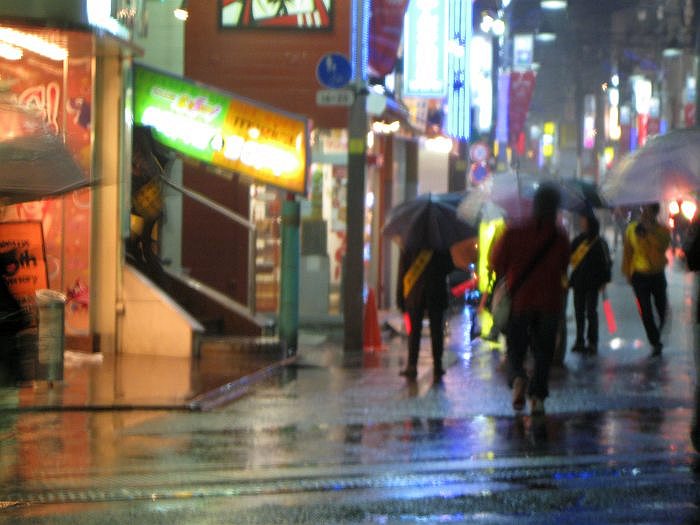
Tokyo, first night. Kim Taylor
As a result, I would encourage anyone wanting to do street photography to be absolutely blatant about it. Put on your tourist hat, your loud tourist shirt, glue your camera to your hand and go look around yourself like a tourist. See everything with fresh eyes, as if you just stepped off the ship from Mars. Who could possibly object to posing for the strange alien visitor?
Now is this exploitative? Should we be offering these locals (even if they're the next block over) some money since we are using their images in our art?
I don't know, if you're getting commercial model releases from them and intend to make a jillion dollars selling stock photography you might just consider it. It's a thought for another day.
Photos don't lie.
Of course they do, they have from the very first image which was created.
Which statement is correct? Well let's assume that folks mean photographs accurately reflect reality. In that case they lie. But if we say that photographs accurately and unselectively record what is in front of the lens, than yes, to the extent of the technology they don't lie.
Let's go with photographs lie for the sake of argument, that they don't reflect reality. How is it that they don't.
Selection of View
Photographers select what they will record. That selection means that some of the scene, some of the reality of what is being viewed is left out. Some of the reality is absent. Last evening someone commented on how harmonious Japan was with respect to humanity and nature, and he cited the lovely zen gardens he'd seen in photographs.
An excellent example of selective view. The garden shown here is from a temple in Kyoto,
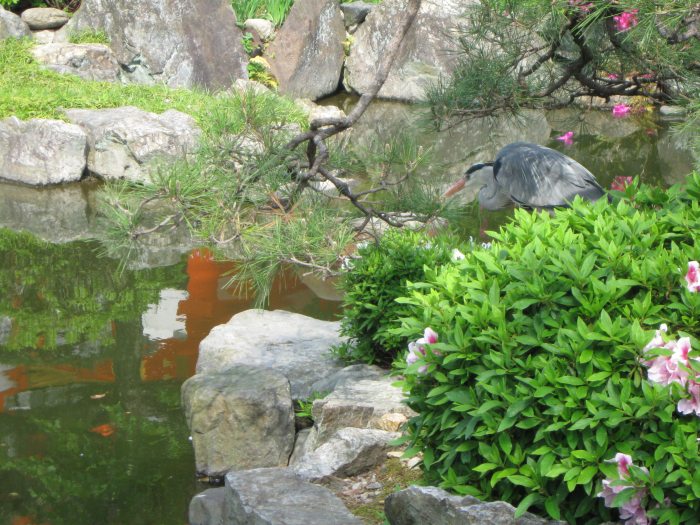
Kim
Taylor: Temple Garden 2009
Lovely, nice heron by the water, lovely flowers and rocks... the garden itself is about 30 by 40 feet if I remember it right, and beside me were about 25 other people snapping pictures. I have a lot of other shots of this temple which looks elegantly lonely and spare... because I spent a lot of time waiting for people to get out of the frame.
Here's my favourite spot on these temple grounds.
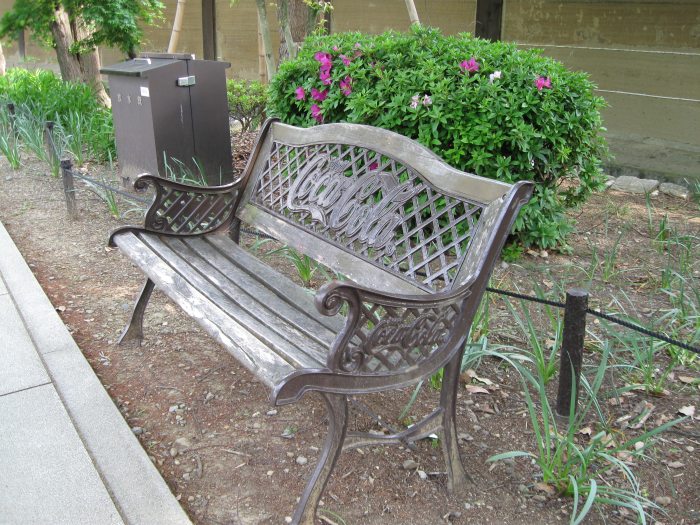
Kim Taylor: Temple Bench 2009
It sums up my impression of the temples of Kyoto beautifully without actually showing the reality which was a hell of a lot of tourists and tourist stands surrounding a wooden building containing a couple of statues.
Selection of Time
Photographers pick the time they capture their image. Does a shot of a beach in winter capture the reality of that beach? There are three other seasons and hundreds of thousands of other weather conditions that are the reality of that beach. The best we can say is that the image is true for that instant in time.
But is it? We can't see a thousandth of a second, plain and simple, we also can't see thirty seconds. Our visual perception of the world is built up in an entirely different way than images are built up on a photographic image.
Lens Characteristics
A "normal" lens is one about 50mm in a 35mm camera. It's supposed to be the field of view that our eyes take in, but my eyes take in considerably less than that. My eyes take in a scene that is sharp from front to back, side to side everywhere I look, and is horribly out of focus wherever I'm not looking. That scene is almost 180 degrees wide if I'm not moving my eyes, and considerably more than that when I do.
My eyes don't forshorten like a telephoto and they don't increase the apparent distance like a wide angle lens. My eyes don't distort shapes, at least not that I notice most of the time, when I put my eyes closer to someone's face. I can force myself to see that distortion but usually it isn't there.
Two Dimensions
I see in three dimensions with binocular vision, I see two slightly different items when I look at something, one for each eye (try it by closing one then the other eye) in a sort of cubist way of seeing that allows me to sort of see around an object. A photographic image has a single point of view and only two dimensions. I can't see around anything in a print except the paper.
All these and many more lies crop up even before we create the print or display the file on a monitor.
Paper Prints
If I print the image out "straight" with no manipulation of the process at all I am creating a lie. The print may be black and white, certainly not reality. If it's colour the paper and the negative both impose changes in the colours that existed in the scene as I captured it.
Of course I can dodge and burn, spot out dust or objects, sandwich negatives... and that's all before we get into any sort of discussion of digital editing.
So it's really not about whether or not photographs lie, they represent their own reality and manipulate the subject matter in various ways so that we may have a hard time understanding what it is we're seeing at the best of times.
Compared to What?
Having said all that, it occurs to me that we are comparing photography to the wrong thing when we are considering a lie or a truth. Photographs don't reflect reality, but that is obvious to everyone. In this discussion what we really should be comparing photography to is artists. Painters lie, photographs don't lie.
Put two different painters in front of a scene, frame it for them and tell them to paint it. You'll get two different images.
Put a camera on a tripod and have two different people release the shutter within a couple of seconds and you'll get two images that are more or less identical. The photographic instrument does not interpret, it reflects. The painterly instrument interprets, it cannot be indiscriminate like the camera is.
Compared to painters, even those who make a serious effort to reflect reality (the photorealists amongst them) the photograph doesn't lie.
Deliberate Manipulation
But it can. We can deliberately manipulate photographs and often do, just as painters manipulate their images, and with digital manipulation we can be as radical as our imaginations can be inventive.
So what do we lie about? What's justifiable? Here is a list of subjects that are photographed.
-landscapes
-fashion
-nudes
-portraits
-commercial ads
-art
-journalism
I would say that in the matter of lies and truth, only one of those matters. It doesn't really matter to most of us whether or not landscapes or fashion shots are manipulated to within an inch of their pixels, but somehow we need to believe that journalistic images are "true".
There's where it starts and there's where I'll stop.
Think for a moment. What are you looking at when you look through your images? Prints in your hand or files displayed on your LCD monitor? I know that for me it's obvious, I have made one single print in the last three months, but I've looked at hundreds of images on my monitor.
I don't think this is the way we will be looking at our images in the future, I think that day is here now.
So how do we display our artwork today? Those images that we have finished and want to show off. For myself I have a few print books around that I used to carry with me, but now I have an ipod touch in my pocket that does that job.
Wall art? I don't think we're quite there yet but how long will it be before someone comes up with a simple device to plug our image banks into that 54 inch display screen hanging on your living room wall? Something that will let you cycle through your artwork at whatever rate you wish for an ever-refreshing bit of eye-candy to make the room complete. For the price of a vintage print you can add another monitor or two to the walls, each perhaps controlled wirelessly from your disk drive. We can already search for images online by colour scheme, so how difficult would it be to match the colours in the wall and the chesterfield, and then have our home entertainment system search the net for an endless supply of images to complement the decor. Display one per day and have a button on the monitor or the control system that stores the image if we like it, another to change it instantly if we hate it.
I think we have seen a shift in the way we view our images, we just haven't caught up with it yet. At least those of us who figure a "real" photograph is a piece of paper that we can hold in our hands haven't caught up yet. The kids likely aren't even thinking about this, after all they have absorbed their visual input from the computer screen and the television for their entire lives.
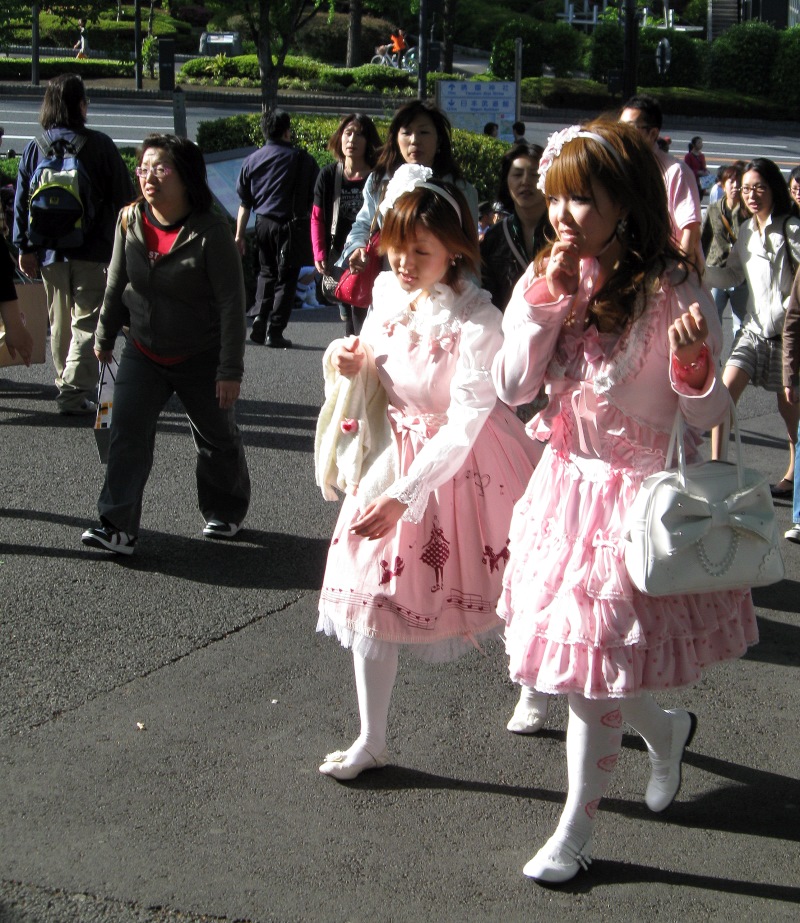
Outside the Tokyo Budokan, 2009
Where does it come from? For me it feels not so much like inspiration but like a pressure that slowly builds up until I have to go out and shoot something, anything. Oh, sorry I suppose I should say photograph something because if I say pressure builds up and I have to shoot something it makes me sound sort of....
Anyway what's your inspiration? What makes you go out and shoot something, or raise the camera to your eye and pull the trigger... er trip the shutter. Let's hope it's something that you like, and not something that you figure you should be shooting.
There are no seasons on photographs, like there is a hunting season on deer and moose and goose and fish. You may figure that you should photograph models, or still life, or landscapes because you see a lot of images out there that you like that are those things. But maybe you don't really get off on it... maybe you spend a lot of money on equipment and spend hours and hours setting up the shot and waiting for the right light and printing to the maximum range of the ink and the paper. Maybe you're "photographing" when you should be out shooting something that turns your crank.
It's OK to like images without trying to copy them. Really, you can like landscapes without the least desire to be the guy out there with an 8x10 and a lifetime supply of D-76 developer.
Think of the poor photographers out there who "had to shoot", the Garry Winogrands, the guys who ended up with hundreds if not thousands of rolls of negatives that never got developed, let alone printed. Think of how many more thousands of those guys are around today with nothing to stop them from rattling off hundreds of files an hour on their digital cameras... at least Winogrand had to reload every 36 shots or so. What is it that they are looking for? Surely after 600 shots you'd get a decent image of the street, or a stop sign, or a pretty girl.
But it's the obsessive looking for something that keeps the juices flowing. Anyone can take a point and shoot digital camera and make a decent image of their cousin these days, but that just isn't the same as feeling sort of uneasy and slightly naked without a camera strapped to your right hand.
Find something that you can obsess over, your model trains, your garden, your gorgeous girlfriend and get obsessive with that camera. Shoot it because you have to, not because you figure you ought to.
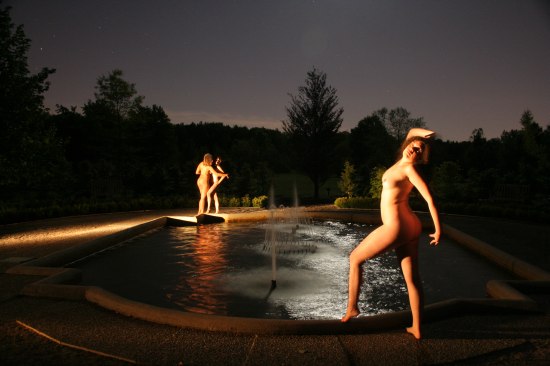
Nobody believes me
but I obsess
over what you can do with light. Here's from my most recent set, the
light source is a 2 million candle power flashlight and the moon.
Three points to the first person to tell me who I was thinking about, and the name of his photograph, when I took this one.
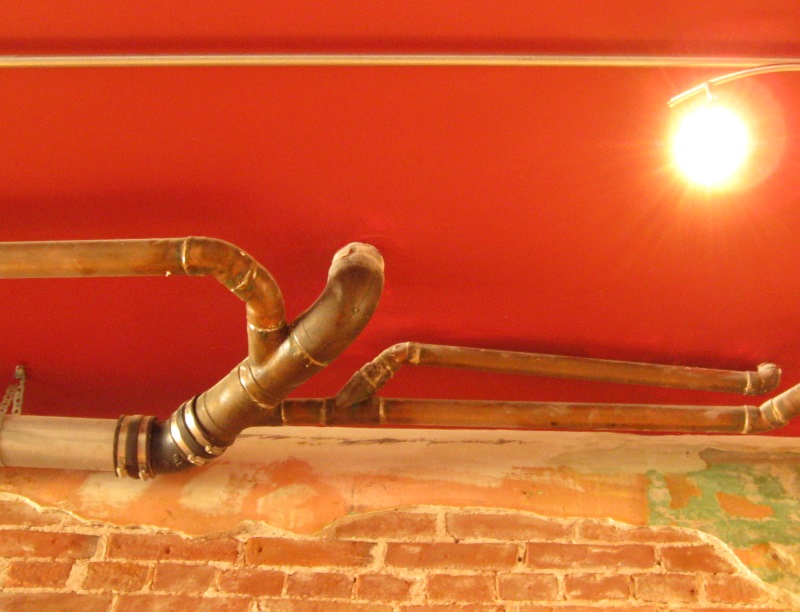
This was taken at an art gallery in Port Dover, Ontario. A strange town on the north shore of Lake Erie, it's been discovered by the cottage crowd from Toronto, the ones who can't afford Muskoka but can afford four times the old price on a cottage in "Dover". A town that is also a more or less permanent home to the middle-aged balding Harley Davidson set who discovered it through the Friday the 13th gatherings of bikers.
So the gallery is on the same street as a Giant Tiger discount store, several leather shops, "The Gay Blade" hair salon and a couple of cottage furniture shops. It's quite a mix.
The point being that no matter where you are, take a look up, a look down, a look around the corner and generally look anywhere other than where you have already looked. I looked up and saw this shot which stuck in my mind for this entire week while I have been trying to get 180 Magazine done for June, and catching up with all the other things that didn't get done in the three weeks I was in Japan or at a budo seminar here in Guelph.
Got it yet? Think Elvis Presley.
I have a Canon A590, a camera I bought for my daughter to take on a trip because she wanted manual control and an optical viewfinder. I ended up liking it so much that I gave it away to a teacher and then bought myself another one.
I don't like the "new and improved" later models, so if you want one, try your local big-box everything store for the remaining stocks.
One of the more interesting things about the camera is something that I'm sure every techno-peeper knows about but I had to stumble across it. Some Canon cameras (the G9 and the G10 both have this feature I discovered) have what they call a digital zoom. No I don't mean the sensor crop feature that you should turn off so you don't zoom into it once you hit the end of the optical range, I mean a digital tele-conversion (as they call it in the manual) for the optical zoom that means that you actually have three different zoom lenses on this one camera.
In the menu you'll find a setting under digital zoom for standard, off, 1.6x and 2x. Off means you only have the optical zoom and standard means you do. The 1.6x setting converts the usually 35-140mm (35mm equivalent) field of view with 1:2.6-5.5 maximum aperature (2.6 at 35mm becomes 5.5 at 140mm) to 58-224. 2x pushes it to 70-280mm.
Simply put, you can get an f-stop of 2.6 at 35mm, 58mm and 70mm. That's a really nice feature for those who like shallow depth of field portraits. Let me put that another way, you can go to aperature control, select f2.6 and switch between 35, 58 and 70mm equivalent without losing aperature speed.
Another feature which I now use is the "anything" button, which I've set up to trigger this feature, one push and I go from standard to 1.6x, another gets me to 2x and finally back again. I use it all the time now that I've discovered it.
This is a very loud statement of who buys these point and shoot cameras, or at least who the companies think buy these things. It's amazing that this feature is buried in the manual instead of being splashed all over every ad. Three optical zoom lenses without changing a lens? Terrific!
I looked hard to see if there was some sort of digital cropping being done here but the files are the same size at each conversion level and I haven't noticed any increase in noise. I assume there's an interpolation going on but it seems to be pretty good, certainly good enough for me since I'm usually pushing my cameras into the "grain" range anyway.
I've got a small bone to pick with digital technology. It's about average white balance and the colour of light. I'm starting to become a bit concerned as the equipment gets better and better.
Here's the shot what got me concerned in the first place.
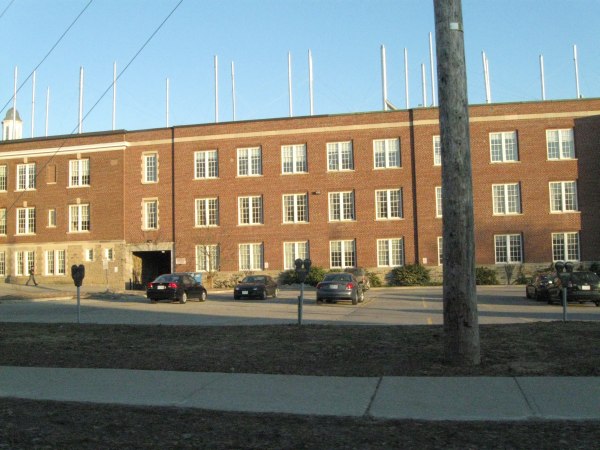
Boring and taken from a moving car as I was heading somewhere else but ignore that. Look at the building and tell me what time of day it is. Now look at the shadows. This was within half an hour of sundown and that building was... you guessed it, golden because it was golden hour.
It's a bit warm, there's no doubt about that, and the sidewalk in shadow is suitably blue as I'd expect but it's nowhere near what the real light was showing me. The average white balance has moved golden hour a long way toward noon.
When I got out of the car I saw a parking sign on a brick wall in the sun and I tried a bit of an experiment.
First the scene with average white balance.
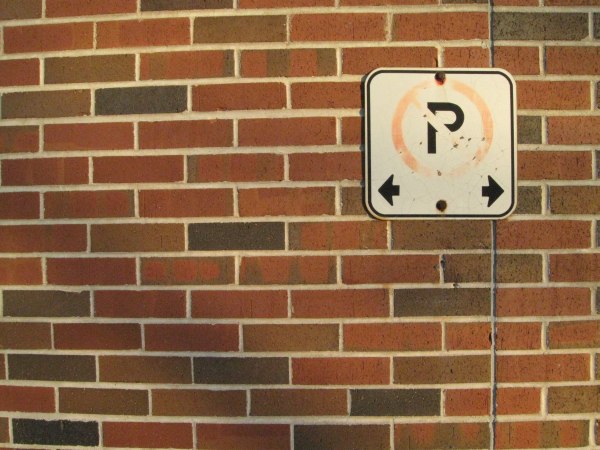
Now with the balance set for shade.
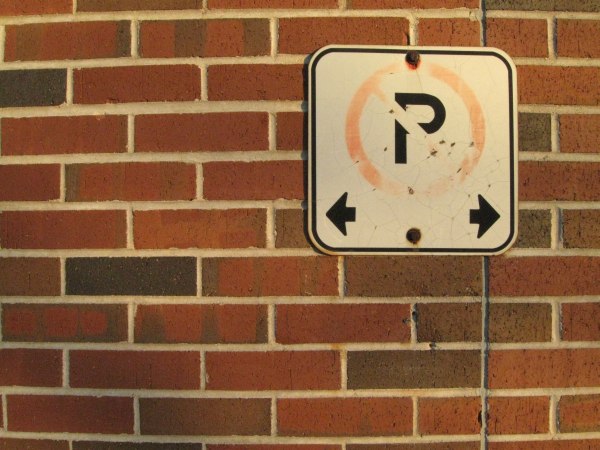
That's forced it a bit more toward the colour I was seeing.
Finally, to be fair, when I did a custom white balance on the sign I got this shot.
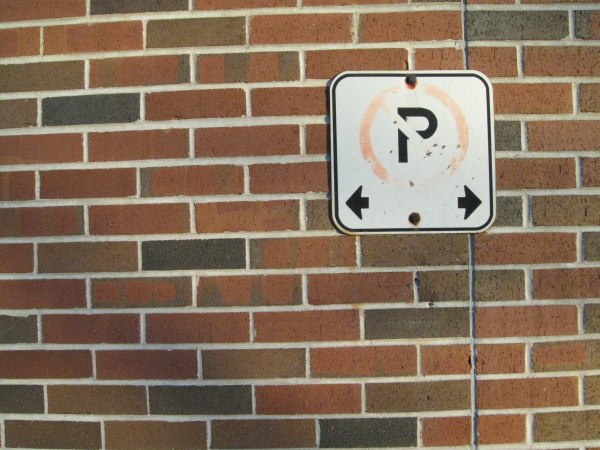
Which actually seems a bit blue. I was in a rush and didn't mess around much... yeah here it is with the levels and colours all "fixed" in post.
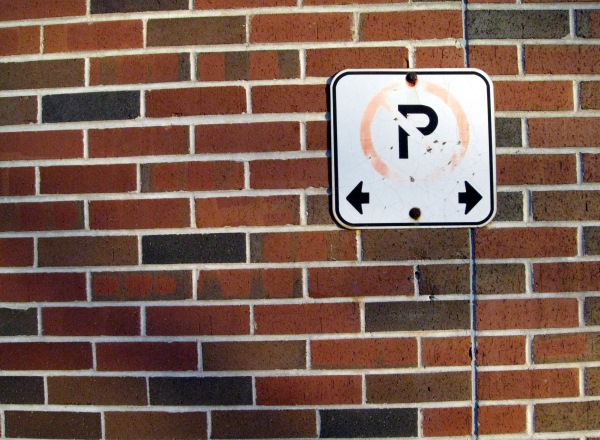
Curiously my brain keeps telling me this is sundown, just because of the shadows I think, the upper right of the sign is warmer than the lower left.
With digital white balances we have no trouble making golden hour look like noontime, but can we make golden hour look like golden hour? I suppose so but I kind of miss not having to worry about the colours when I'm shooting at different times of the day. I couldn't worry about them once I had the film in the camera unless I wanted to start messing around with filters.
There are a couple of cameras out there that have film emulation modes which might set a firm colour balance, or I suppose I could do a custom white balance at noon and then just wait for evening. I see that this new camera I'm playing with will actually keep the custom white balance setting so that's a possibility. I know it's a bit much to ask on a point and shoot that I can set the colour temperature manually. Maybe I'll add the proper colour paint chip to my bag to set the custom white balance in golden hour light so I don't have to remind myself to set it at noon.
Yow, now it's getting too complicated for me to figure out.
In this article from the Telegraph it is suggested that Caravaggio may have used a mixture of crushed fireflies along with white lead and mercury to set his images on canvas before painting them. If true, we'd better start calling him a photographer who "tinted" his images rather than a painter.
I think it's rather an open secret that a lot of the old masters used a camera obscura or other optical device to do their preliminary sketches at least, but at around 1600 this would be the earliest instance of a fixed chemical image that I've ever heard of.
I've always been fascinated with Caravaggio's lighting which seems to come from everywhere at once, and the article mentions that he used a dark room with a hole in the ceiling along with a mirror and lens to project the scene onto the canvas. I had at one time surmised that the easiest way to duplicate his lighting would be to use the light painting technique where you hold the shutter open for several seconds while you go around the subject with a flashlight.
It seems that the master may very well have been "painting with light".
I finally found a Freeman Patterson book that I was inclined to buy. It is his Photo Impressionism and the Subjective Image with Andre Gallant (Key Porter 2001). The book is all about "analog" (film), techniques for creating lovely, painterly effects.
One of the techniques involves sandwiching slides. Make a shot in focus, zoom in a bit and make another shot that is out of focus. Sandwich them and check out the effect.
Reading this I decided to try a digital version. Take a shot, make another layer that is 103% larger and put it out of focus, fool with the opacity and you've got the effect below.
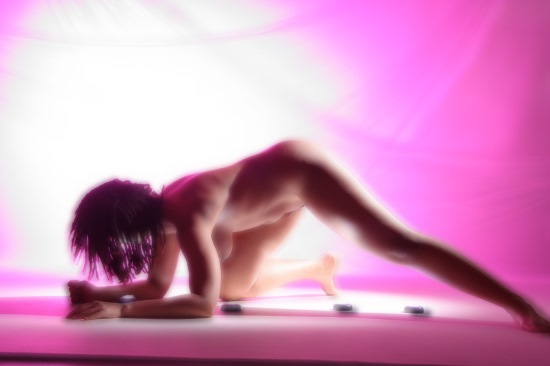
Not really "diffuse glow" so I'm inclined to like it, (really don't like to use canned effects, somehow I feel like they're cheating). Having said that, compared to Freeman's work I still feel like a bit of a fake doing this, he had to take the shots, adjusting the exposure at the time of the shot, then wait for development and hope that things work out. In comparison I took all of five minutes on my shot, the trickiest part was moving the two images around to make sure they lined up nicely.
Yes it's not done "in camera" but I've explained before that I'm not married to in camera work, I'm just not inclined to spend hours editing. If I were to do this in camera I'd try a dark studio, put all the lights on a peanut (a light sensitive trigger on the flash). Then I'd stop down so I had a good long exposure time, get out my on-camera flash, hold it in my hand and pop it once in focus, defocus and shift the zoom and pop the lights again.
Note the LED lights underneath the model, they'd still be doing their thing with the long exposure (as they did in the original shot which was a long exposure combined with a flash.
So there's two techniques to try in digital by reading a book concerned with analog techniques. Don't assume you have to read a book on Photoshop effects to find something new to try, just keep an open mind and look for what works.
Every so often the problem of copying work that has been done before comes up. It might just be a desire to do something new, or it may be a story on a photographer who has copied something and been nailed for it.
Not so long ago a story in Slate magazine appeared describing how Horst and Daniel Zielske were accused by Peter Bialobrzeski of ripping off his views of Shanghai. The shots were indeed made from similar viewpoints and at similar times of day. The problem of course is that anyone can stand anywhere and take a shot at any time of the day, all those "scenic outlooks" are there because something is scenic. To think that your shot, taken where so many others have stood before, is unique is a bit of a stretch.
Not so long before that story, William Klein had obtained a large settlement from John Galliano over the latter's copying of Klein's painted over contact sheets. The problem I have with this one is that when I saw the campaign I thought Galliano was ripping off Peter Beard who was painting frames around his photographs (often with blood) in the mid-'60s while Klein's painted over contacts were done a generation later.
I'm sure by now you've discovered all sorts of other examples of photographers ripping off earlier photographers from your explorations beyond the links above. It seems that you need only name a photographer and with a little effort you will find who did it the generation before. Joel-Peter Witkin? Pretty original to be sure, check out Hans Bellmer. It's a fun game.
So what do we do if we don't want to copy someone who worked before us? Some folks claim "I don't look at the history of photography because I don't want to be influenced."
A noble thought to be sure, but there are two problems, the first is that we can't avoid looking at images, either contemporary or historical. By the time we pick up a camera we have digested a huge quantity of images, likely more than any human has in all the generations that came before us. How do we avoid being influenced by that? We can't of course. The second problem is that even if we succeed in avoiding all influence, we are still going to be reinventing the wheel. Is there a shot or a treatment of a photograph that hasn't been done before?
The solution then is obviously to look at history and avoid doing what has been done before yes? Yes I will look at what has been done and I will do something different, I will find a new way to photograph.
I just did a google image search on Niagara Falls and got 3 million hits in 0.42 seconds. Putting quotes around the search got me 2.6 million images. "Half dome yosemite" came up with a more human-seeming number of 18,800 images. Let's see if we can find a new way to photograph half dome then. I'll check out the images that exist first... at three seconds per image that will take me just under 16 hours. Niagara Falls would take 104 days straight.
It's pretty obvious that we can't avoid copying somone else's work by checking out all the work done, we'd never get to our own photography.
The only possible answer is to simply go out and shoot what you wish, in the way you wish, and work toward your own vision of the world without worrying about ripping off someone else. If you like the way Ansel Adams shot Half Dome, go shoot it the same way. If you see where William Klein stopped too soon with his painted contact sheets, go carry on from there.
Art is intensely personal and extensively cooperative at the same time. All human endeavour is. We build our future on the past. Copyright was originally intended to promote invention and originality, not to prevent it.
Go forth and shoot what you see.
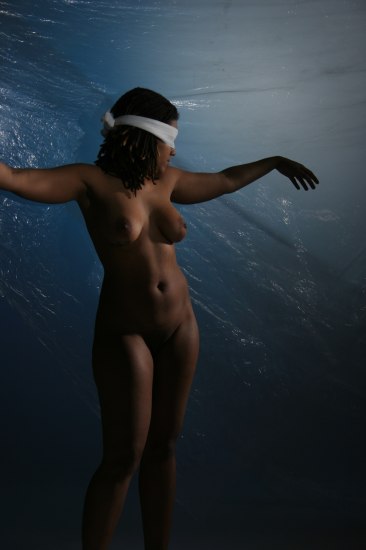
Kim Taylor 2009, Girl with Blindfold
Cool, "girl with blindfold" gets me 126 hits in Google and none of them seem to have a blue background!
